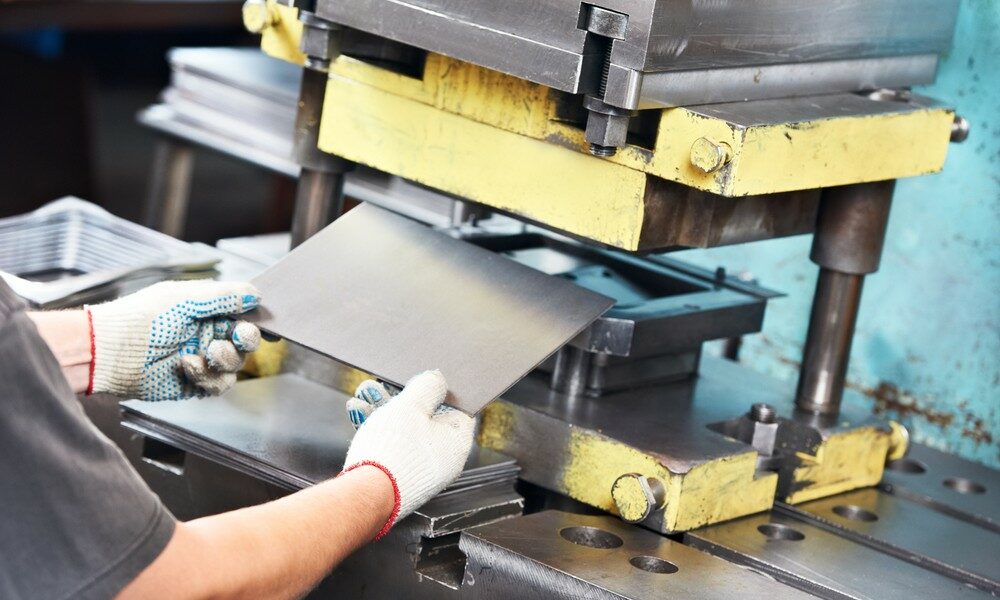Advanced Techniques in Metal Stamping for Precision Production
As industries continuously require better resistances and complex styles in their metal elements, the pursuit for sophisticated strategies in steel stamping has escalated. From the usage of advanced multi-stage marking procedures to the integration of innovative automation modern technologies, the landscape of steel stamping is undergoing a profound improvement.
Advanced Multi-Stage Stamping Procedures
Discussing the intricacies of sophisticated multi-stage stamping procedures exposes the innovative strategies used in modern manufacturing practices. Metal Stamping. Multi-stage stamping is a complex process that includes several steps to transform a flat sheet of metal into a final stamped item. Making use of progressive dies, where different operations are carried out at each stage of the stamping process, permits high precision and efficiency in the manufacturing of intricate steel components
Throughout the preliminary phases of multi-stage stamping, the flat metal sheet is fed right into the marking press, where a collection of passes away are utilized to cut and shape the material. Succeeding phases include extra developing, bending, and punching operations to more improve the component. Each stage is thoroughly developed to build upon the previous one, leading to the production of intricate geometries with tight tolerances.
Advanced multi-stage marking procedures need a high level of knowledge and precision to make certain the top quality and consistency of the stamped parts. By making use of advanced machinery and tooling, suppliers can generate a large range of metal components with performance and accuracy.
Accuracy Tooling Innovations
Accuracy tooling developments have changed the steel marking sector, improving efficiency and top quality in producing procedures. These improvements have considerably affected the way steel elements are generated, causing higher accuracy and uniformity in the end products. One essential innovation is the advancement of computer numerical control (CNC) modern technology in tooling style and manufacture. CNC systems permit detailed layouts to be converted directly right into tooling, guaranteeing precision and repeatability in the marking process.
Moreover, the assimilation of sensing units and real-time surveillance capabilities in precision tooling has enabled producers to discover and attend to problems immediately, decreasing downtime and lowering scrap prices. By including clever modern technology right into tooling, drivers can enhance specifications such as pressure, speed, and alignment during the marking procedure, causing boosted item high quality and enhanced efficiency.

Automation in Metal Stamping
The evolution of accuracy tooling developments in the metal marking industry has actually led the way for considerable innovations in automation, changing the manufacturing landscape in the direction of enhanced efficiency and productivity. Metal Stamping. Automation in steel marking entails making use of sophisticated equipment and robotics to do numerous jobs commonly executed by human drivers. This shift towards automation offers various advantages, consisting of improved accuracy, quicker manufacturing cycles, and reduced labor expenses
One key element of automation in metal stamping is the execution of computer mathematical control (CNC) systems, which enable exact control over Read Full Report the marking process. CNC innovation permits the development of complex and intricate metal get rid of consistent top quality. Additionally, automated systems can be programmed to run constantly, resulting in greater outcome prices and shorter lead times.
Furthermore, automation boosts work environment safety by minimizing manual handling of heavy products and decreasing the danger of accidents (Metal Stamping). As manufacturing industries proceed to accept automation, the future of steel stamping holds great assurance for also higher effectiveness and advancement
High-Speed Stamping Methods

Among the key benefits of high-speed marking techniques is the capacity to produce a huge quantity of parts in a shorter amount of time contrasted to standard stamping techniques. This raised efficiency not just enables makers to meet limited production due dates yet additionally enables expense savings via economic situations of range. Furthermore, high-speed stamping can help in reducing material waste by optimizing the material official site use throughout the marking procedure.
Additionally, high-speed stamping techniques typically integrate ingenious features such as quick die modification systems and real-time tracking capacities, additionally boosting the total effectiveness and versatility of the steel check my reference marking procedure. As modern technology proceeds to breakthrough, high-speed stamping is anticipated to play a critical duty in driving the future of precision production.
Quality Assurance in Stamping Operations
Efficient high quality control steps are essential for ensuring the reliability and uniformity of metal marking operations. Quality assurance in stamping operations involves a series of systematic processes targeted at finding and stopping problems in the made parts. One crucial element of top quality control in steel stamping is using innovative inspection techniques such as optical examination systems and coordinate measuring equipments (CMMs) to verify the measurements and tolerances of stamped components.
Additionally, top quality control actions in marking procedures frequently consist of the application of statistical procedure control (copyright) techniques to keep an eye on the production process in real-time and guarantee that it continues to be within acceptable restrictions. By evaluating data and identifying fads, suppliers can proactively address any type of deviations from the desired top quality criteria.
Moreover, quality control in steel stamping procedures additionally involves extensive material testing to guarantee that the raw materials made use of fulfill the needed requirements for the stamping process. This may consist of conducting material hardness examinations, tensile strength tests, and dimensional inspections to ensure the top quality and honesty of the stamped parts. In general, carrying out robust quality control measures is critical for attaining high-quality stamped components regularly.
Conclusion
In conclusion, progressed techniques in steel stamping play an important role in accuracy manufacturing processes. Through multi-stage stamping procedures, innovative tooling services, automation, high-speed strategies, and extensive high quality control actions, producers can accomplish greater degrees of precision and effectiveness in their operations. These developments in steel stamping modern technology have allowed firms to create complicated components with tight tolerances, inevitably resulting in enhanced item top quality and client contentment in the production sector.